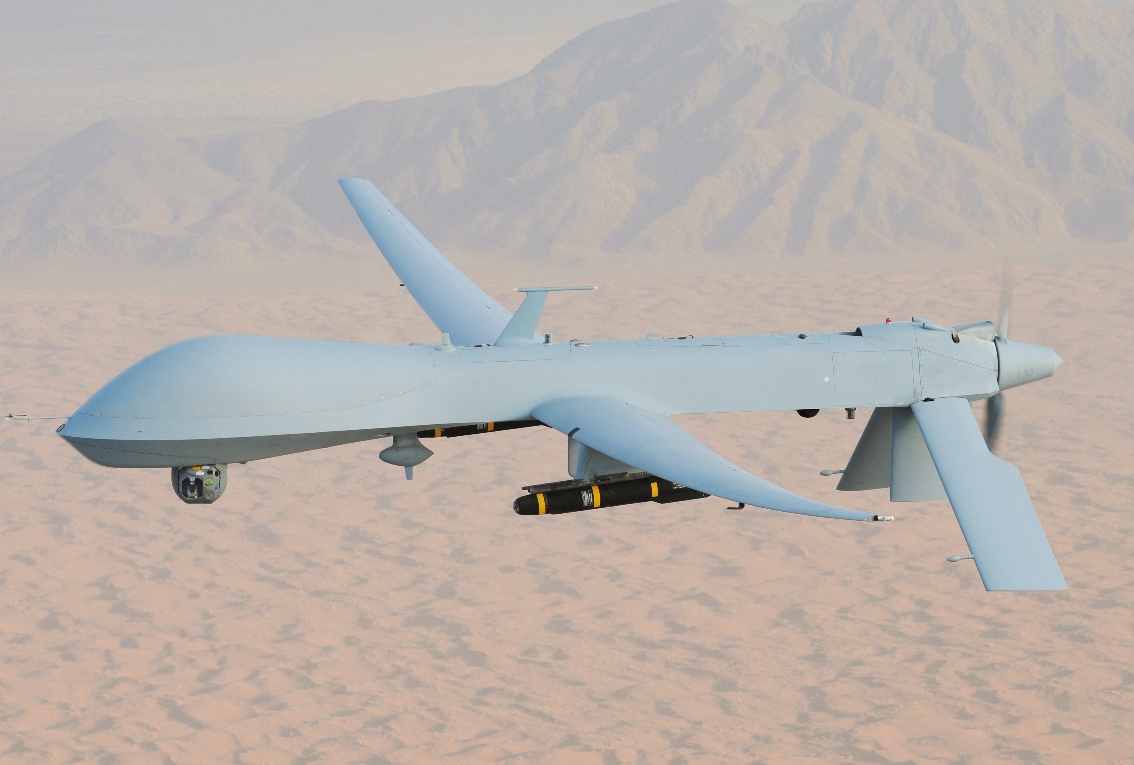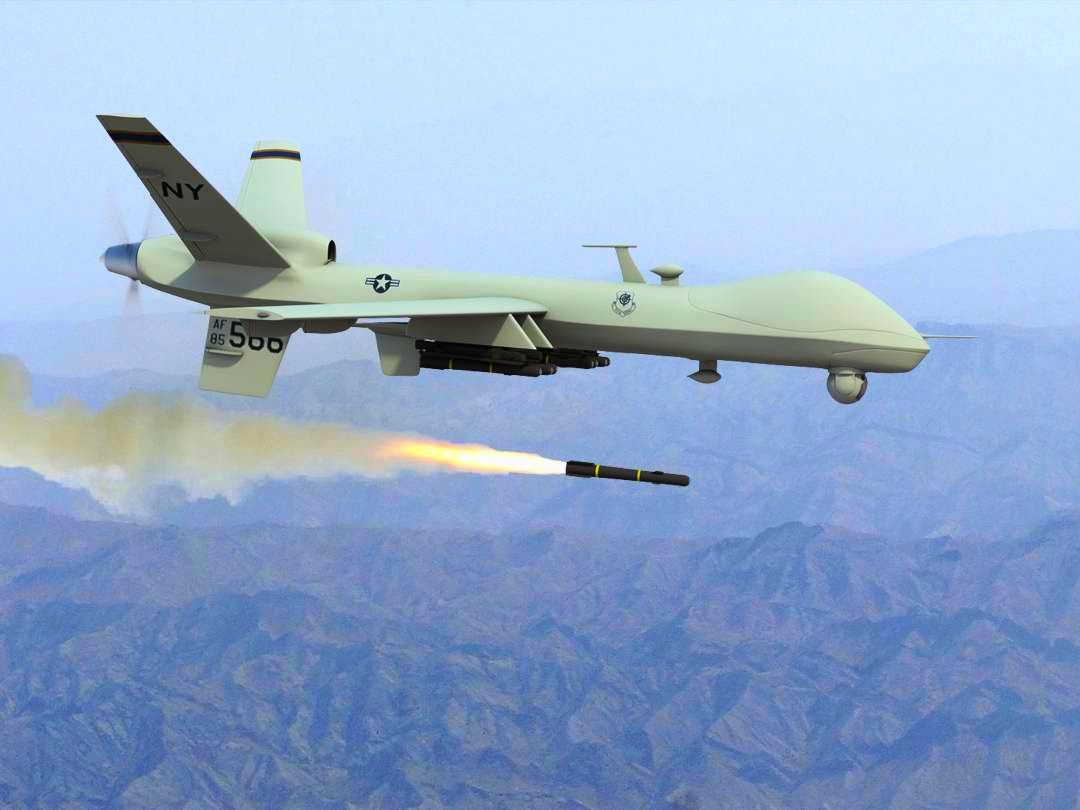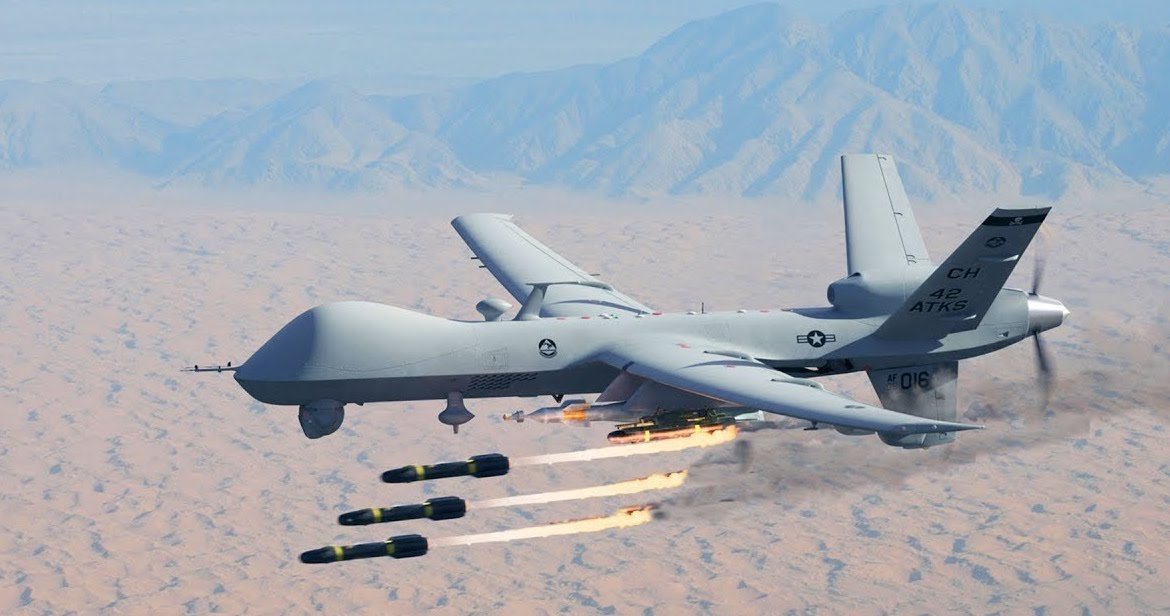Indian PM Narendra Modi, who is on a three-day visit to the US, met with General Atomics Chief Executive Officer Vivek Lall on Thursday (September 23). The company manufactures the MQ-9 Reaper drones, which the Indian armed forces are set to procure.
US Air Force Adopts ‘Augmented Reality’ To Train Its Fighter Pilots ‘Dogfight’ Chinese, Russian Jets
“Drones are an upcoming sector in India and it is of particular interest to the youth. Interacted with Mr. Vivek Lall of General Atomics Global Corporation and spoke about how India is ushering a paradigm shift in drones policy, seen in our PLI (Production-Linked Incentive) scheme and reform measures,” Modi tweeted after the meeting.
Lall said that US companies viewed India as a very promising investment destination. “There are a lot of potential areas of collaboration that we are in discussions with. I think, US companies and many of my colleagues in US companies see India as a very promising destination,” he was quoted as saying by India media.
According to news agency PTI, Lall said that a “dedicated drone hub can be created in India to support the entire ecosystem of drones”.
He also said that the policies and reforms that have been implemented by the countries could benefit each other and also termed it a “sustainable model.”
Drones is an upcoming sector in India and it is of particular interest to the youth. Interacted with Mr. Vivek Lall of @GeneralAtomics Global Corporation and spoke about how India is ushering a paradigm shift in drones policy, seen in our PLI scheme and reform measures. pic.twitter.com/8cEE2YcJ2s
— Narendra Modi (@narendramodi) September 23, 2021
The Indian Navy already operates two MQ-9B SeaGuardian drones from General Atomics on lease from the US to develop maritime awareness. Impressed with its operational performance, the armed forces signed a contract for the procurement of 30 MQ-9B drones, 10 for each service.
‘Black Hawk Down’: Will US’ Iconic Helicopters Be Replaced With ‘Super Chopper’ – Defiant-X For Indo-Pacific Ops?
A $3B Defense Contract
A tri-services contract worth $3 billion for 30 MQ-9Bs is in the works. Once inducted, these combat drones are expected to bolster the offensive and surveillance capabilities of the Indian armed forces.
The drones currently used by the Indian military are designed for Intelligence, Surveillance and Reconnaissance (ISR) missions and not direct combat. The procurement of MQ-9Bs would mark the first tri-services induction. Chief of Defence Staff (CDS) General Bipin Rawat is tasked with ensuring effective tri-service integration.
Following clearance by the Defense Acquisition Council (DAC), the Cabinet Committee on Security (CCS), India’s apex body on national security issues, will need to give the final nod for procurement.

The proposed induction of the MQ-9Bs would give India the distinction of being the only non-NATO country to receive these combat drones from the US. India’s interest to procure MQ-9Bs was first shown in 2019, under the Trump administration, which had approved the sale.
Also called Reaper or Predator-B, these drones have been used by the US military and the Central Intelligence Agency (CIA) in conflict zones.
Iran’s Major General Qaem Soleimani, who served as the commander of the Quds Force of the Islamic Revolutionary Guards Corps, was killed in a US drone attack at the Baghdad international Aiport on January 3, 2020.
There is common confusion over the Predator and Reaper drones and as a result, they are used interchangeably. The original Predator designated as the MQ-1 was the brainchild of General Atomics. It was commonly known as the Predator drone. This remotely piloted weapons system quickly garnered a lethal reputation after eliminating several high-value targets with the use of its surface-to-air missiles.
Shrouded In Secrecy, US Finally Confirms ‘Big Development’ On Next-Gen Stealth Bomber – The B-21 Raider
The Predator MQ-1 was succeeded by the Reaper MQ-9 which was also known as the Predator B and bears an uncanny resemblance to the Predator MQ-1. This led to confusion. However, they are two distinct systems.
The MQ-1 Predator
The US Air Force’s (USAF) 11th and 15th Reconnaissance squadrons operated Predator drones. A total of 268 Predator drones were delivered to USAF which was completed by March 2011. The Italian Air Force procured half a dozen Predator drones which were deployed to Iraq in January 2005. GA-ASI delivered the final two Predators to the Italian Air Force in 2015.
Predator drones had been deployed to support NATO, United Nations, and American troops in the warzones of Bosnia since 1995. These unmanned combat aerial vehicles (UCAVs) were also deployed during Operation Enduring Freedom in Afghanistan and Operation Iraqi Freedom.
The Hellfire-C laser-guided missile was fired successfully from the Predator in February 2001 at Nevada’s Nellis Air Force Base.

After a successful evaluation, the Predator drone was deployed in combat operations where it was used to fire Hellfire missiles in war-torn Yemen in November 2002. A civilian vehicle believed to have been carrying terrorists was eliminated using this weapon system.
In August that year, a Northrop Grumman Bat submunition was dropped successfully and a FINDER mini-UAV war launched from a Predator drone.
A total of 36 additional MQ-1B Predators equipped with Hellfire missile installation kits were procured by USAF in September 2007 and as aforementioned; the final MQ-1 Predator was inducted in March 2011. However, by March 2018, USAF’s entire predator fleet was formally decommissioned. The service then began operating the MQ-9 Reaper drone as its primary combat drone.
The MQ-9 Reaper
The MQ-9 Reaper evolved from the Predator MQ-1 after USAF awarded a further contract for the system design and development (SDD) of the UCAV in March 2005. The 42nd Attack Squadron was the first USAF MQ-9 Reaper squadron based in Nevada’s Creech Airforce Base.
The ‘BIG’ Indian Connection: How France-US Spat Over AUKUS Pact Has ‘Direct Links’ With New Delhi?
The Reapers were first deployed in active combat to Afghanistan in 2007 where they carried out precision airstrikes and then in Iraq in 2008. In January this year, Reaper drones were deployed to Romania by USAF to carry out ISR missions in support of NATO.
The Reapers has a 27-hour endurance and a maximum take-off weight of 4.7 tons, which is over four times that capacity offered by the Predator. The Reaper has an external weapons payload capacity of over one ton, which allows it to carry as much as four Hellfire missiles along with two 227-kilogram bombs whilst on the same mission.

This is much more than two Hellfire missile capabilities of the original Predator. Both the Reaper and its predecessor are controlled by satellite data links by personnel on the ground.
The maritime variant of the Reaper, which was on lease to the Indian Navy under an emergency procurement is designated as the MQ-9B SeaGuardian. This version of the Reaper is optimized to carry out maritime reconnaissance and anti-submarine warfare (ASW).
General Atomics has also indicated its potential use in underwater mine detections. The SeaGuardian variant has a higher MTOW and operational endurance than its sister variant. The maritime combat drone can stay operational for around 40 hours and take off with 5.6 tons of weight.
Delays
There is a substantial delay in acquiring the lethal drones that India is keen to induct. There are two main reasons — the cost of the deal and the length of the process.
Since the cost of this deal through the US’ foreign military sales (FMS) program is quite high, India wants more clarity on the deal.
New Delhi reportedly demanded additional details on the exact price fixation, the technology transfer that the deal will entail as well as the repair and maintenance facilities that will be established in India for the drones.
The second reason has to do with the length of the process. After receiving useful insights into the specifics of the agreement, the acquisition pact will be moved for “acceptance of necessity” by the Defence Acquisitions Council headed by Defense Minister Rajnath Singh.
Once this is done, the country will issue an actionable Letter of Request to the US administration, which must then respond with a Letter of Offer and Acceptance and notify the US Congress of it. Post this, the final contract will be inked.

Since most of the discussions have already taken place, this process should have progressed relatively fast, which is clearly not the case. According to the Times of India, after an initial 15% downpayment, the process then involves paying the balance in installments spread over 5 or 6 years.
Why Are They Important For India?
The Indian armed forces currently lack indigenous combat drones. The country has at least a decade of technological asymmetry with Pakistan with regards to combat drone technology and is significantly behind China.
Boeing F-15EX Fighter Jets Pitched To Indian Air Force To Have Indigenously Developed Aerostructures?
India’s indigenous UCAV projects like the Ghatak under the aegis of the Defence Research and Development Organisation (DRDO) is still years away.
The procurement of the combat-proven Predator MQ-9s from the US is likely to bridge this gap in its inventory, especially at a time when Pakistan is looking to procure combat drones from Turkey. Turkish combat drones played a decisive role in the 2020 Nagorno-Karabakh conflict, which shifted the global military focus towards drone warfare.
The induction of the MQ-9 Reaper would bolster the Indian armed forces’ offensive capabilities. Most importantly, the Indian military would be able to carry out precision strikes on terrorists’ hideouts and launchpads across the de facto border in Kashmir.
These drones could also be used on the Ladakh frontier where Indian and Chinese troops have been locked in a standoff for more than a year. Additionally, the Indian Navy could deploy them as a reconnaissance and potential offensive tool against any misadventure in the Indian Ocean Region (IOR) by the Chinese PLA Navy (PLAN).
“The involvement at the highest level for what appears to be the acquisition of UAV-related technologies is suggestive of a realization of our increasing vulnerabilities gap. It’s hoped that the significant software and skill capabilities of Indian industries could be leveraged to build future platforms and weapon systems,” Rear Admiral Vineet Bakhshi (Retd) told the EurAsian Times.
- Aritra Banerjee is a defense journalist who has worked in both online and print media. He has laid an emphasis on issues related to military human resources, tactical psychology, military-media relations, professional military education, and combat fitness. He can be reached at aritrareporter@gmail.com.
- Follow EurAsian Times on Google News




